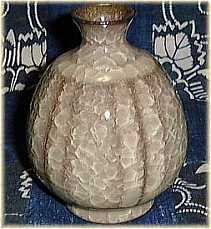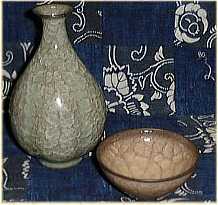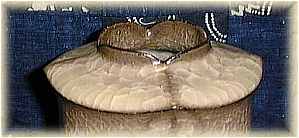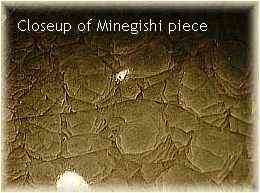|
 The Work of Seiko Minegishi The Work of Seiko Minegishi
The Master of Difficulty
Of all the styles of pottery in this grand world of ours, celadon (seiji in Japanese) is one of the most difficult to master. An extremely high loss rate of up to 80% means that most potters shy away from this style, as most ceramists are unwilling to take such high financial risks. Japan boasts the most diverse styles of ceramic art in the world today, yet those successfully working in celadon can be counted on one hand. Among them is Seiko Minegishi (1952 to Present).
Minegishi came to fire and champion celadon on a roundabout path. He first worked in the Kohiki style, an iron-rich clay body covered with a white slip modelled after Korean Yi Dynasty (1392-1910) Punch'ng wares. He achieved success in this style but found a gap between kohiki ware and the forms that he wanted to make. Not all styles of pottery take well to certain shapes; rarely is seen, for example, a Ki (Yellow) Seto fresh water jar (mizusashi) or a Black Seto vase. After seeing a large Chinese celadon bowl in the Tokyo National Museum, Minegishi found a style that fit his precisely potted forms. He then visited and researched the classical celadon collections in the Taiwan and Korean National Museums. Experts say that the best celadons the world has ever seen are from the 12th-13th century Southern Sung Dynasty China imperial court sanctioned Chiao-t'an kilns. These wares are known as Kuan ware - Kuan meaning "official."
 Minegishi, after "visually digesting" these celadon masterpieces was now ready to test his clay (a blend of Seto, Mino, and Shigaraki clays), glazes, kiln and sanity. Five years and 6000 tests later, not to mention the increase in gray hairs on his head, he finally found the right firing process that produced the beautiful deep crackles (kanyu) like that of Kuan wares that had been so elusive in his celadon quest. Kanyu is like layers of onions that overlap upon the powder blue or soft green surface forming glass-like geometric etchings. His pieces seem more like sparkling semiprecious stones or fine jade than a high-fired stoneware. Minegishi, after "visually digesting" these celadon masterpieces was now ready to test his clay (a blend of Seto, Mino, and Shigaraki clays), glazes, kiln and sanity. Five years and 6000 tests later, not to mention the increase in gray hairs on his head, he finally found the right firing process that produced the beautiful deep crackles (kanyu) like that of Kuan wares that had been so elusive in his celadon quest. Kanyu is like layers of onions that overlap upon the powder blue or soft green surface forming glass-like geometric etchings. His pieces seem more like sparkling semiprecious stones or fine jade than a high-fired stoneware.
Another triumph for Minegishi was his success in including deep purple lines that suffuse the crackled glaze. Minegishi finds the inspiration for his art, like most great artists, in nature, most notably in a simple egg. The large jar's (see below photo) smooth, rounded oval shape enhances the ethereal powder green thickly applied glaze. Sharply cut, low relief ridges(shinogi) were cut into the clay which allowed the glaze to form circular layered rivulets in the depressed lines. This gives the vase a visual texture while the oscillating lines at the top add motion. A 'bald' patch on the shoulder offers an intriguing contrast to the bold, vertical shinogi cuts. One more ovoid piece is the vase with subtle diagonal cuts and a flared fluted lip. Two other vases show Minegishi's mastery on the wheel for any hesitation, posturing, or lack of craftsmanship, would easily be spotted on the precisely potted surface.
 |
|
|
|
Above Item Entitled Beishoku Shinogi-te Kabin.
(see closeup of lip below)
|
|
 |
The shinogii technique can be seen on most of Minegishi's work and this is where he has perfectly matched his thrice applied glaze to form. Three lovely incense burners are accentuated by Minegishi's deftly placed incised lines. One has a swirling flow and low cut base that sets the piece in a gyrating dervish dance. The two others have more stately, classical, and reserved temperaments. All three would send up a godly fragrance to heaven in a most revered manner.
Tea utensils are also part of Minegishi's repertoire. He makes the often dismissed celadon chawan (tea bowl) more approachable. The wabi-cha tea masters of old appreciated the muted earth tones of native stonewares like Bizen or Shigaraki or the warmth of glazed wares such as Shino or Karatsu for tea utensils over the costly imported Chinese celadons favored by the Ashikaga shoguns. Ever since celadon tea devotees have been far and few between. Minegishi has not slavishly copied Sung celadon bowls but has found in them a spirit, an inspiration, that he directs into his humble clay jewels. A pumpkin-shaped ridged water container would hold water like a crystal pool and any of the three chawan would rest comfortably in royal hands or those of a pauper -- a tea bowl sees all as equal.
 I must be honest now and say that I was never too crazy about celadon; its calculated perfection paled in naturalness and humanity to the rough, blistered wares of the wood fired kilns. Yet something struck my soul when I first saw Minegishi's celadon- it was different then so many lackluster pieces of other modern day celadonists that I had so regrettably seen before. I was speechless as the beauty of color and form permeated my senses. And others in Japan have felt the same also as evidenced by his pieces being selected for a recent Japan Ceramic Exhibition and the Japan Traditional Crafts Exhibition. He has also been one of a handful of Japanese ceramists to have a show in a museum- for Minegishi it was Nasu's Queen Museum. "I'm down to a forty-percent loss rate now and I feel I've gotten my shapes down to near perfection", Minegishi told me recently. His kiln is named 'Fusou-gama' which means 'alking and creating' and this forty-something good-looking potter has found in the royal celadons of the past a way to bring their beauty into the present age. Minegishi is walking and creating in a spirited pace that shall bring him into the spotlight of world class celadon artists in the not too distant future -- a future that shines like the surface of his breathtaking pottery. I must be honest now and say that I was never too crazy about celadon; its calculated perfection paled in naturalness and humanity to the rough, blistered wares of the wood fired kilns. Yet something struck my soul when I first saw Minegishi's celadon- it was different then so many lackluster pieces of other modern day celadonists that I had so regrettably seen before. I was speechless as the beauty of color and form permeated my senses. And others in Japan have felt the same also as evidenced by his pieces being selected for a recent Japan Ceramic Exhibition and the Japan Traditional Crafts Exhibition. He has also been one of a handful of Japanese ceramists to have a show in a museum- for Minegishi it was Nasu's Queen Museum. "I'm down to a forty-percent loss rate now and I feel I've gotten my shapes down to near perfection", Minegishi told me recently. His kiln is named 'Fusou-gama' which means 'alking and creating' and this forty-something good-looking potter has found in the royal celadons of the past a way to bring their beauty into the present age. Minegishi is walking and creating in a spirited pace that shall bring him into the spotlight of world class celadon artists in the not too distant future -- a future that shines like the surface of his breathtaking pottery.
Learn More About Minegishi Seiko
|